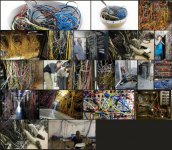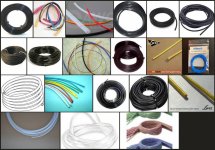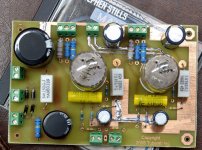Good morning!
I‘m distracting myself with some literature about wires, cables, interconnects etc.
Here and there I read about Spagetti. Nowhere did I found an explanation or illustration of it, so ...
What does Spagetti mean in the context of wires?
(like in DIY Silver RCA Interconnect Cables )
I‘m distracting myself with some literature about wires, cables, interconnects etc.
Here and there I read about Spagetti. Nowhere did I found an explanation or illustration of it, so ...
What does Spagetti mean in the context of wires?
(like in DIY Silver RCA Interconnect Cables )
Last edited:
So one meaning seems to be „utter mess“...
I didn‘t just gave up searching an found this : TEFLON-07 | Extruded Teflon PTFE spaghetti tubing, int. dia. 4mm | Buy on-line | rf-microwave.com
Plain hollow wire tubes...
ok, now I see, he used only "spaghetti" which confused me too as I thought of "cable spaghetti", but "spaghetti tubing" or "extruded tubes" gives a different result, new picture added. 🙂
PTFE Spaghetti Tubing | Allied Wire and Cable | Distributor & Manufacturer
Extruded PTFE Spaghetti Tubing | Insulation Products Corporation
Otherwise cable spaghetti is as the previous picture shows.
Urban Dictionary: cable spaghetti
PTFE Spaghetti Tubing | Allied Wire and Cable | Distributor & Manufacturer
Extruded PTFE Spaghetti Tubing | Insulation Products Corporation
Otherwise cable spaghetti is as the previous picture shows.
Urban Dictionary: cable spaghetti
Attachments
Oh wow, I never even considered "spaghetti mess" as a sense.
Spaghetti, when I was learning, meant small tubing you slipped over a component lead to keep it from touching some other nearby component lead. This was important in point to point wiring like old TV sets. many of us just reach for a piece of insulated wire, strip off a piece of insulation, and use that instead of buying actual spaghetti.
Spaghetti, when I was learning, meant small tubing you slipped over a component lead to keep it from touching some other nearby component lead. This was important in point to point wiring like old TV sets. many of us just reach for a piece of insulated wire, strip off a piece of insulation, and use that instead of buying actual spaghetti.
many of us just reach for a piece of insulated wire, strip off a piece of insulation, and use that
instead of buying actual spaghetti.
And then you know what the actual voltage rating is.
If the litterature that mentions "spaghetti" is old, they are talking about a slip on wire covering that was quite common in the days before heat shrink was invented.
It got the name from the common white rubber like version that was used to dress up wiring made with uninsulated hook up wire back in the 1950's through the early 70's. I assumed that the term had vanished with the rubber like tubing, but Googling "spaghetti tubing" brings up several links to the modern version.
The term "spaghetti wiring" can also refer to a mess like shown in the previous images. I prefer the terms "rats nest" and "furball" to refer to something like the prototype seen in the attached images. Believe it or not, it is a working amp made with lots of clip leads, which eventually got distilled into the PC board shown.
The term "spaghetti code" refers to the stuff I write for Arduino and other small systems. At least that what my teachers in Computer Engineering classes called it.
It got the name from the common white rubber like version that was used to dress up wiring made with uninsulated hook up wire back in the 1950's through the early 70's. I assumed that the term had vanished with the rubber like tubing, but Googling "spaghetti tubing" brings up several links to the modern version.
The term "spaghetti wiring" can also refer to a mess like shown in the previous images. I prefer the terms "rats nest" and "furball" to refer to something like the prototype seen in the attached images. Believe it or not, it is a working amp made with lots of clip leads, which eventually got distilled into the PC board shown.
The term "spaghetti code" refers to the stuff I write for Arduino and other small systems. At least that what my teachers in Computer Engineering classes called it.
Attachments
If the litterature that mentions "spaghetti" is old, they are talking about a slip on wire covering that was quite common in the days before heat shrink was invented.
It got the name from the common white rubber like version that was used to dress up wiring made with uninsulated hook up wire back in the 1950's through the early 70's. I assumed that the term had vanished with the rubber like tubing, but Googling "spaghetti tubing" brings up several links to the modern version.
The term "spaghetti wiring" can also refer to a mess like shown in the previous images. I prefer the terms "rats nest" and "furball" to refer to something like the prototype seen in the attached images. Believe it or not, it is a working amp made with lots of clip leads, which eventually got distilled into the PC board shown.
The term "spaghetti code" refers to the stuff I write for Arduino and other small systems. At least that what my teachers in Computer Engineering classes called it.
Cool!
I always admire prototyping folks (and the rototypes)—doing stuff like that (or p2p etc. is to me like making art...
Bob Pease's Famous Breadboard - RF Cafe
Cross-reference: Is this supposed to work?
A name given to insulating tubing meant to be slipped over exposed conductor in wiring. The original spaghetti was a woven cloth impregnated with a sealing agent to stiffen it and add insulating protection.
Tubelab, that is not a rat nest just organised confusion. 🙄 For me that is.
Amplidude - love it with some wine😀
with some wine😀
Amplidude - love it
 with some wine😀
with some wine😀Fusilli would be the separator inside CAT6 then, and penne would be heat-shrink tubing? Be great to see twisted-pair pasta and ribbon-cable style lasagna! And spirawrap 🙂
Spaghetti code, meaning poorly/randomly structured computer code, has been around for a long time.
Spaghetti code, meaning poorly/randomly structured computer code, has been around for a long time.
Hmm, and ribbon cables would be fettuccine. Dang, now I really fancy some spaghetti/fusilli/pasta-of-some-sort bolognaise. With a glass or two of pinotage.☺
the stuff I write for Arduino and other small systems
Spaghetti code, meaning poorly/randomly structured computer code
I worked my way up from the assembly line at Motorola to being a product development engineer without a formal college degree. After 4 or 5 years as an engineer, I had run into some advancement roadblocks, so Motorola offered me the opportunity to get an "engineering" degree on THEIR dime. I chose computer engineering since it was offered at a nearby expensive private school.
According to one of my college teachers in the late 80's / early 90's, I took the term spaghetti code to new levels. I once asked him to help me with a program I was writing for work, which when printed out was about 15 pages long. He said that I would get an "F" if I turned something like that in during one of his classes (too many global variables). He could write it in 2 or 3 pages, in a style that I could not follow. My program did work and each separate action or thought was on it's own line. That's all that mattered to me.
That experience taught me that I lacked two of the primary requirements for being a programmer.....patience, and a structured, logical mind with the ability to think ahead (I sucked at Chess too). That teacher knew this and often gave assignments to torture those (like me) that didn't get it. Try writing a linked list on a disk drive using pointers. Note.....don't do this on a hard drive......
I took the "C" and "C++" languages, tossed out everything that I did not fully understand, or often made mistakes with, like pointers, and created a language I called "C--." Today we call that an Arduino Sketch. The Arduino compiler, like Borland C++ in the 90's, will eat my old code and compile it with few if any changes. I have written an "Analog Emulation" music synthesizer in C-- and have it running on a Teensy 3.6 board. It's about 5 pages long, and only lacks the Marinara sauce!
It used to be another name for heat-shrink
It's possible, but anything that I saw called "spaghetti" in the 60's and 70's was non shrinkable. I don't have anything that I built from that time period, but we got this white rubber stuff from the TV repair parts jobber that looked a lot like thick spaghetti with a hole through it, except that it was TOO white. I often just stripped the insulation from #14 house wire or hookup wire, and used it.
Tubelab, that is not a rat nest just organised confusion.
Many of my projects start out with a rats nest....then the organization gets applied.
Here is an example.
The first picture shows a simple 5 tube guitar amp made on perf board for the Hundred Buck Amp Challenge. It's a simple rats nest because it's a simple design. Eventually it morphed into a 4 tube design as I kept taking stuff out of it and tweaking the design. These serve as experiments to find a design worthy of further investigation.
The rats nest served it's purpose, and has since been recycled into several different amps with 4 or 5 tubes in each. None have been worthy of further research, so it's in the box of dead projects where it gets robbed for parts, or maybe gets to live on as another rats nest experiment.
The second picture shows a completed PCB which was created from the rats nest seen in the first picture. It needed one flying cap to clean up some hum at max gain.
The third picture shows that PCB stuffed into a simple box with a minimal chassis. This was the design submitted for the HBAC. The HBAC had run its course, and this was a complete working guitar amp made for about $50 in material. It did it's job, but didn't ROCK, and wound up in a box when I had to move out of Florida in a hurry.
Fast forward two moves and about 3 years and I find that little amp in a box. I hook it up and thrash on it, but it doesn't ROCK. The original HBAC thread devolved into a lot of disputes about what constitutes a TUBE amp, so no semiconductors were allowed, except in the power supply. OK, the HBAC is done, so now I can make this thing into something I LIKE. It comes out of the box, and I turn that clean PCB layout into a second generation rats nest. See picture.......I spent about two weeks tweaking on it until.......now it ROCKS!
Again I turn the rats nest into a nice PCB, and the amp is reborn again. This time I make a better chassis, but after almost three years of sometimes daily use, I still haven't put it back in the box.
The new amp is sitting on top of the speaker. The remains of the old one is on top of the spectrum analyzer to the right of my head. It's now in the box of dead projects.
There is a point in every project where the rats nest needs to get some organization or mistakes will be made. Sometimes mistakes can be ugly or dangerous when playing with high voltage.
This prototype only existed for one week. It had a 1/4 inch thick Lexan shield between me and it during development and testing. There are only two or three pictures that were taken with the shield down while under power, and I was safely across the room. WHY, there is 1500 volts at in that yellow Radio Shack clip lead! Note the tube socket made with vice grips and hose clamps.
Attachments
-
 NewGuitar_x.jpg862.3 KB · Views: 109
NewGuitar_x.jpg862.3 KB · Views: 109 -
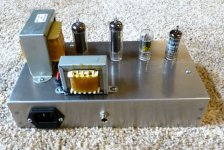 Chassis_2_x.jpg544 KB · Views: 95
Chassis_2_x.jpg544 KB · Views: 95 -
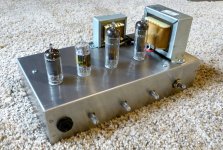 Chassis_1_x.jpg601 KB · Views: 92
Chassis_1_x.jpg601 KB · Views: 92 -
 It Rocks_x.jpg838.2 KB · Views: 110
It Rocks_x.jpg838.2 KB · Views: 110 -
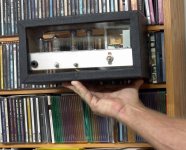 AlmostDone.jpg526.5 KB · Views: 111
AlmostDone.jpg526.5 KB · Views: 111 -
 Bottom_A.jpg205.1 KB · Views: 94
Bottom_A.jpg205.1 KB · Views: 94 -
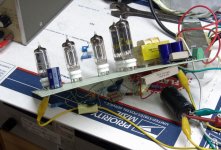 Amp1_0_A.jpg101 KB · Views: 112
Amp1_0_A.jpg101 KB · Views: 112 -
 200Watts_x.jpg701.4 KB · Views: 97
200Watts_x.jpg701.4 KB · Views: 97 -
 StratFeedback1.jpg744.8 KB · Views: 112
StratFeedback1.jpg744.8 KB · Views: 112
- Home
- Design & Build
- Construction Tips
- What is „Spagetti“?
